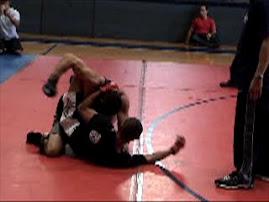FIGHTING FOR THE RIGHT TO FIGHT:
PART I -- FEMINIST GAINS IN MMA
[Cross-posted on FightTicker.com]
Like other sporting industries, mixed martial arts (MMA) is a microcosm of society at large. Demographic patterns and social movements in sport frequently reflect broader societal trends seen beyond athletic courts, arenas, fields, or in this case, the cage. August 15's Strikeforce card, titled "Carano vs. Cyborg," is being heralded as a symbol of women's progression in MMA, with Gina "Conviction" Carano and Christiane "Cyborg" Santos competing in the card's main event match.
In the YouTube video below, veteran MMA commentator and analyst Mauro Ranallo states, "You talk about ground breaking, that's never happened before where a female mixed martial arts fight headlines a card featuring the guys." Ranallo is absolutely correct.
Still, women's headway into MMA has come with steps forward and back in the sport's short lifetime. While "Carano vs. Cyborg" is both a symbolic and real representation of feminist gains in sport, within the wider spectrum of the industry, MMA tends to follow the gendered patterns of society at large that maintain male privilege.
This is the first of a 3-part series focusing on the state of women in MMA. With the August 15 Strikeforce card less than a week out, a good deal of attention will be paid to that event. However, this series will attempt to address women in MMA as a whole, placed in the historical context of women's athletics since the turn of the twentieth century.
[Cross-posted on FightTicker.com]
Like other sporting industries, mixed martial arts (MMA) is a microcosm of society at large. Demographic patterns and social movements in sport frequently reflect broader societal trends seen beyond athletic courts, arenas, fields, or in this case, the cage. August 15's Strikeforce card, titled "Carano vs. Cyborg," is being heralded as a symbol of women's progression in MMA, with Gina "Conviction" Carano and Christiane "Cyborg" Santos competing in the card's main event match.
In the YouTube video below, veteran MMA commentator and analyst Mauro Ranallo states, "You talk about ground breaking, that's never happened before where a female mixed martial arts fight headlines a card featuring the guys." Ranallo is absolutely correct.
Still, women's headway into MMA has come with steps forward and back in the sport's short lifetime. While "Carano vs. Cyborg" is both a symbolic and real representation of feminist gains in sport, within the wider spectrum of the industry, MMA tends to follow the gendered patterns of society at large that maintain male privilege.
This is the first of a 3-part series focusing on the state of women in MMA. With the August 15 Strikeforce card less than a week out, a good deal of attention will be paid to that event. However, this series will attempt to address women in MMA as a whole, placed in the historical context of women's athletics since the turn of the twentieth century.
A Brief History of Women in American Sport
Sports began to flourish in the United States right around the late 1800s when women began pushing more fervently for suffrage and against family violence. Athletics popularized as part of a larger backlash against the women's movement. As women advocated for their right to play sports, their inclusion was conceded with two primary conditions: (1) "true" women would not play sports that involved heavy contact or pounding (e.g., basketball, boxing); and (2) "acceptable" women would play non-contact sports that supposedly portrayed physical beauty and grace (e.g., swimming, tennis, golf, figure skating).
 Babe Didrikson (right) is widely considered the greatest female athlete of all time. Initially, she excelled in sports considered "non-feminine" for her time, including basketball and track & field.
Babe Didrikson (right) is widely considered the greatest female athlete of all time. Initially, she excelled in sports considered "non-feminine" for her time, including basketball and track & field. Didrikson later focused exclusively on golf so that she would be accepted by society and could earn a living as a female athlete.
Didrikson later focused exclusively on golf so that she would be accepted by society and could earn a living as a female athlete.In comparison to minority women, these conditions privileged upper-class white women who had economic access to "acceptable" women's sports. But overall, sports helped to define "proper" womanhood in terms of bearing children. Medical doctors at the time stated that even mild collisions in sport would jeopardize childbirth even if female athletes were not pregnant. Consequently, women's inclusion in sports such as tennis, coupled with their exclusion from sports such as basketball was rooted in how they were valued as mothers who could procreate, rather than their right to play whatever sport they chose.
As the decades passed, women's sports developed structurally in comparison to a privileged male standard. Women were completely excluded from some competitions (e.g., women did not compete in Olympic marathons until 1984 since long distance running was said to jeopardize reproductive organs; they did not compete in track & field's pole vault until the 2000 Olympics due to their alleged lack of upper body strength). The time frame was shortened for some women's sports (e.g., women play the best 2/3 sets in tennis matches, as opposed to men who play the best 3/5). And for some sports, particular components differ due to men being on average, of larger physical size (e.g., the net is set shorter in women's than men's volleyball)**. Additionally, obvious disparities exist in the amount and type of coverage women's athletics receive in the media.
 Prior to 2000, women were not allowed to compete in the pole vault. In 2000, Stacy Dragila became the first woman to win Olympic gold. Her personal best is 15'10".
Prior to 2000, women were not allowed to compete in the pole vault. In 2000, Stacy Dragila became the first woman to win Olympic gold. Her personal best is 15'10".Feminist Gains in MMA
Although women have not yet penetrated MMA's most prestigious MMA organization (the UFC) and do not comprise a large proportion of all fighters, the fact that women are competing in MMA at all is significant. Contemporary female athletes in sports involving heavy pounding and physical contact (e.g., track & field, soccer) compete relatively free from large public criticism.
However, professional fighting takes sporting contact and collisions to another level, involving the intentional infliction of pain through strikes and submissions. Within the MMA industry, very little overt criticism has been expressed suggesting women should not compete simply because it makes them unfeminine. There is disinterest by some, but not extensive criticism. And often times, female fighters receive great support from the largely male fan base. In contrast, some sports analysts are upset simply because female tennis players are said to grunt too loudly.
Another sign of women's headway is the inclusion of 5-minute rounds. The more widely viewed women's MMA matches have involved 3-minute rounds (e.g., EliteXC’s matches from 2007 and 2008), suggesting, like the gendered time differences in tennis, that women are unable to fight effectively in matches with 5-minute rounds. However, in addition to the upcoming Strikeforce main event, a number of MMA organizations have promoted women's MMA matches with 5-minute rounds.
In recent years, Bodog and the Ultimate Warrior Challenge held women's matches with 5-minute rounds. As early as 2002, Hook-N-Shoot promoted 5-minute round women's matches, showing that in this regard, many female fighters have been given the opportunity to compete on the same terms as their male counterparts. Said Dr. Rosi Sexton of female mixed martial artists fighting 5-minute rounds as a standardized practice and the progress of women's MMA as a whole (September 2008 interview):
I think it will come. I mean everyone is saying women should fight 5-minute rounds. The fighters are saying it. The commentators are saying it. The reviewers are saying it, and I think eventually, it will have to happen. It's just a question of when, so I'm just gonna have to hang in there and wait for the inevitable. The thing is when you get caught up too much on things like that, you tend to miss that fact that we are so much farther along than we were before.
 Dr. Rosi Sexton (10-1-0) locks down an armbar. According to Dr. Sexton, all but one of her 11 professional MMA matches have been scheduled for 5-minute rounds, a marker of gender equity.
Dr. Rosi Sexton (10-1-0) locks down an armbar. According to Dr. Sexton, all but one of her 11 professional MMA matches have been scheduled for 5-minute rounds, a marker of gender equity.Finally, while in competition, female mixed martial artists are not sexualized nearly as much as women in some other sports. Take for example, Anna Kournikova in tennis. Obviously, she and other athletes have been sexualized outside of sport through modeling opportunities (and some athletes actively pursue those opportunities).
However, even while in competition, predominantly male commentators have harped on Kournikova's physical aesthetics more so than her athletic talent. Likewise, in the Olympic Games, commentators tend to focus on domestic issues (e.g., mothering, romance) significantly more with female than male athletes, and media conglomerates provide greater air time to women's sports that bear more skin, frequently using camera angles that provide for a sexualized gaze, which impacts women in society differently than men.
 Both in and out of competition, Anna Kournikova and other female tennis stars have been disproportionately celebrated for their physical beauty by sports media.
Both in and out of competition, Anna Kournikova and other female tennis stars have been disproportionately celebrated for their physical beauty by sports media. Some sports scholars theorize that in addition to being gifted athletes, 2008 Olympic gold medalists Kerri Walsh and Misty May, received such a large amount of air time because of their aesthetic appeal.
Some sports scholars theorize that in addition to being gifted athletes, 2008 Olympic gold medalists Kerri Walsh and Misty May, received such a large amount of air time because of their aesthetic appeal.Conversely, commentary in MMA matches with women tends to be focused simply on the fight. And while women, like male MMA fighters, bear skin in competition, this is simply part of MMA. As in sports like track & field and volleyball, minimizing clothing is essential to freeing oneself so an athlete can compete at an optimal level. Most female fighters wear clothing that is simply athletically utilitarian without accentuating their sexuality. And again, media coverage while in competition has been athletically focused in MMA (both visually and verbally), more so than media covering some other women's sports that incessantly highlights female athletes' physical beauty.
 In Sydney's 2000 Olympic Games, commentators repeatedly made note of Marion Jones's smile. Male athletes, such as Michael Johnson, also smiled frequently, but were described more so in patriotic and athletic terms.
In Sydney's 2000 Olympic Games, commentators repeatedly made note of Marion Jones's smile. Male athletes, such as Michael Johnson, also smiled frequently, but were described more so in patriotic and athletic terms. Above, Iman Achhel competes against Felice Herrig in a UWC match. The gendered commentating practices that occur in many other sports happen less frequently in MMA matches involving women.
Above, Iman Achhel competes against Felice Herrig in a UWC match. The gendered commentating practices that occur in many other sports happen less frequently in MMA matches involving women.
-------------------










thanks for this! I've been struggling with MMA and wondering what a feminist analysis would look like on the sport.
ReplyDeleteLet's drop the pretense. Just let her fight men and let her be destroyed.
ReplyDeleteAgain, your response is fighting? What would you hope this would accomplish - definitive proof of male superiority or something?
DeleteI would much prefer to watch two grannies battle it out with lethal knitting needles.
ReplyDeleteAnd deadly pins. Think of all the blood.
Its obvious the maa is just too soft..